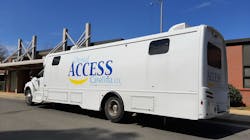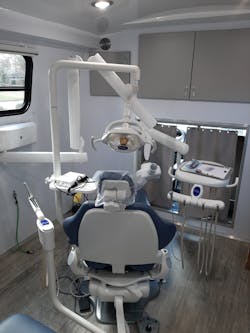The world as we know it is changing before our very eyes. With COVID, the rapidly declining state of geopolitical affairs, and domestic issues here at home, it is painfully obvious that we must do things differently. We cannot continue to operate in the same way we always have.
Paradigm shift
It is rare when a paradigm shift comes from someone who has spent their career in the field where the shift occurs. Take email, for instance. The US Postal Service never saw that one coming! Many readers here have never known life without email. The powers that be in dentistry are no less blind. They are trying to fit a real problem of today into a box built at least 100 years ago. Just as email and social media have changed the way people communicate, mobile dentistry has changed—and will continue to change—the way people access dental care.
Related reading:
- Improving seniors’ quality of life through mobile dentistry
- Mobile dentistry and teledentistry: Are you in or out?
- 5 ways teledentistry can improve the oral health system
One of the best ways to improve access to care is to expand the number of providers who properly and ethically practice in mobile dental clinics. By taking the service to the people, the major barriers for those least likely to get care by traditional means are removed. Sadly, the “establishment” in dentistry still fails to recognize the value of mobile dentistry and its impact on improving access to care in a variety of arenas, not the least of which are the low-income and elderly populations. The many factors inhibiting access are too complex to discuss in this article, but it is certain that they don’t rest on dentistry’s shoulders alone, and the problems cannot be solved by simply throwing money at them. However, two major barriers to receiving dental care—transportation and logistics—can be influenced by the dentist.
Consider this: a mobile clinic arrives at a place where patients regularly visit, like a school, community center, elder care facility, office complex, or manufacturing facility. Patients are treated on site with minimal interruption to their normal day. Complex logistical issues such as transportation for the elderly or disabled are eliminated. Productivity increases because downtime from late arrivals or broken appointments disappears. More patients receive care who might otherwise be left without it or receive only symptomatic care.
Mobile dentistry is a subject that has sparked much debate. Many believe that mobile and portable dental operations are only appropriate for preventive care in schools, or that they are fly-by-night, profit-driven clinics that operate without regulation or morality. Failed government-sponsored programs further perpetuate the myth that mobile dentistry doesn’t work.
Enter the private, for-profit mobile practice. Like 99% of traditional dental practices, they neither receive grant money nor rely on third-party sources to cover expenses. By using sound business principles and efficient systems, we can accomplish our goals of serving those in need and earning a respectable living!
While the opportunities for mobile dentistry are many, our practice, Dental Access Carolina (DAC) has a 21-year proven track record of success providing ethical, high-quality dental care to economically disadvantaged patients. In doing so, we also generate a nice living for our staff and our families. We took a free enterprise approach to a public health problem, and everyone wins.
Sadly, with more than two decades of success, we have failed to break the mindset of brick-and-mortar practices that has been in place for more than a century. However, this seems to be changing, especially after the COVID crisis.
A change in mindset
In addition to an emerging new mode of delivering dental care, the mindset of those who deliver care is also changing. New dentists today are less likely to own practices, and I’ve observed a more altruistic spirit in them. The reasons for the shift in practice settings are many, but most new dentists are saddled with massive student loan debts. Even so, I have seen many disparage the profit-driven practices of their predecessors in deference to serving those in need. Unfortunately, those two worlds collide when it comes to economics. New dentists must make enough money to repay their student loans, and they feel they cannot give back until that issue is solved. As a result, many opt for associateships in large corporate practices with guaranteed incomes where some feel they are selling their souls by “feeding the corporate monster” in order to survive. This leads to significant professional dissatisfaction in many cases because the dentist feels trapped.
Profitable mobile dentistry
The myth that providing quality care to low-income patients is not a viable business proposition has been disproved by us, as has the myth that high-volume modes of practice are the only way to be profitable in the Medicaid arena. DAC’s chief dental officer, James Hicks, DMD, states, “The most common model for dealing with the low-income patient base relies on volume to reach production goals. The schedule is essentially ‘overbooked’ significantly to compensate for high cancellation rates and no-show patients. This results in a very busy schedule with limited time per patient. Treatment is almost always completed piecemeal or begun and not completed in complex cases because of the multitude of required appointments.
With our model, we see fewer patients but complete more treatment in a shorter time due in large part to our seeing only one patient at a time. The appointment length and amount of treatment completed can be tailored to the individual. There are many benefits for patients. Complex procedures like root canals are routinely performed on teeth that would doubtless be extracted in most other practices due to the time required to complete the treatment.” Dr. Hicks goes on to explain, “We also enjoy a much higher compliance rate from patients. This, I am certain, is due to the amount of time we can spend building trust. We complete more treatment simply because our patients are more comfortable and at ease during the average appointment [which, incidentally, is done without the use of sedation, nitrous, or restraints]. We are not rushed or forced to treat ‘what hurts more,’ and we are not bound by an appointment schedule. This enables the symptomatic patient to be rendered pain free, with the remaining treatment completed at the next visit.” Another young doctor at DAC stated, “[This is a] unique opportunity to help the most underserved patient population: low-income children. It is extremely satisfying to know that you are the only outlet of dental care for some children.”
The compensation structure for doctors in our practice is generous and promotes teamwork. We employ sound business principles and systems in all phases of our operation, from verification of patient eligibility to our repeatable and consistent clinical functions, to our mobile clinic design. There are many moving parts (no pun intended) to our operation. To the untrained eye, what we do looks very easy, but trust me, our success is based on more than two decades of experience, most of which was trial and error!
Attention to detail is paramount
We are very specific, almost to the point of being dogmatic, in almost every phase of our practice, because we have learned from making almost every conceivable mistake. We have arrived on-site to perform composite restorations, forgetting the curing light. We have had to abort treatment because the generator ran out of gas before we finished. There have been a host of other similar problems. As a result, we have developed tried-and-true systems and procedures that are easy to duplicate and easy to teach.
While we are always open to improving our efficiency, it is sometimes hard to convince some doctors that we do things for a reason, and that deviating from the standard protocol in one area results in a breakdown in another, nor matter how simple it may seem. We want the playing field to be level for everyone, every day. Said best by Michael Schuster, DDS, from Scottsdale, Arizona, “Systems run the practice and people run the systems.” By having consistent, repeatable systems in place, ideally we can plug any person into the system at any location and the practice runs seamlessly. This concept is what afforded McDonald’s the opportunity to sell billions of hamburgers with mostly high school students as employees.
Consider mobile dentistry
So, to new graduates considering where to practice first, consider mobile dentistry. Done right, it can be both financially and altruistically rewarding. It’s a valid way of delivering dental care in the 21st century, and its time has come!
Editor's note: This article appeared in the June 2022 print edition of Dental Economics magazine. Dentists in North America are eligible for a complimentary print subscription. Sign up here.
About the Author

John E. Reese III, DMD
John E. Reese III, DMD, graduated from the Medical University of South Carolina in 1988, where he has also been an adjunct professor. He is a fellow in the Pierre Fauchard Academy and the International College of Dentists. In January 2001 he founded Dental Access Carolina (DAC), a mobile dental practice providing comprehensive care to economically disadvantaged children. Dr. Reese builds mobile clinics and offers consulting on practice management and mobile dentistry. To learn more, visit dentalaccess.com.
Updated June 23, 2022

